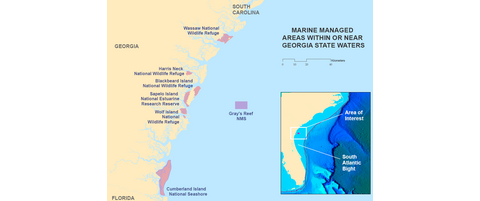Just prior to the holidays, Lad Akins and I had the pleasure of joining the Gray's Reef Research Area Working Group (RAWG) in Savannah, Georgia. Gray's Reef National Marine Sanctuary (GRNMS) is one of 14 National Marine Sanctuaries, perhaps less well known to many of you than Stellwagon Bank or Monterey Bay Sanctuaries, and is located some 32 kilometers off the coast of Georgia. Remember that there has recently been an addition to our sanctuaries by George W. Bush (2006) in establishing Papahanaumokuakea Marine National Monument, including and extending beyond the Hawaiian archipelago. GRNMS is rectangular in its defined borders and is roughly 6.5 km N to S by 9 km E to W (17nm2) and is a popular site for recreational fishing and boating. Previous mapping and assessment studies have shown there to be 4 main benthic habitats within GRNMS that include flat sand, rippled sand, sparsely colonized live bottom, and densely colonized live bottom (ledges).
The workshop I attended was the latest iteration of several previous meetings that had the intention of exploring the concept of placing a research area (RA) inside the boundaries of GRNMS. The focus of the latest workshop was to specifically address what scientific data would be collected inside the proposed RA. The RA would be an area specifically designated for conducting controlled scientific studies in the absence of confounding factors such as recreational or commercial fishing. Previous workshops had convened to decide on biological, ecological, and socioeconomic variables that all would contribute to deciding on where to place the RA inside GRNMS borders. Deciding on the optimal RA configuration (square, hexagon, etc.), location within the sanctuary, and size (area) of the RA for biological questions alone led to some 35,000 options after detailed matrices were created to quantify a best fit design for the RA. "Best fit" in this case is a site that would minimize impact on bottom and recreational fishermen, have a high species richness and biomass, and would have strong research and educational value. And the research and public comment phase of this project has been ongoing for almost 10 years in a collaboration between a number of multidisciplinary groups. The magnitude of the previous work to date on establishing this RA along with the talented group assembled at this past workdshop really impressed me. Furthermore, the dedication and commitment of numerous individuals and agencies in developing management tools that consider multiple stakeholders such as recreational and commercial fishing interests, scuba divers and spear fishermen, and boaters, were equally impressive. If the general public had insight into how complicated decisions such as the one this group convened are to make, they would have more empathy for the folks making these decisions.REEF's direct interest in establishing an RA within GRNMS is that we will likely be leading the fish monitoring component of the ongoing studies for the newly established RA. Of course, there will be many studies occurring within the RA involving benthic ecology, discarded gear assessments, and numerous studies quantifying the effects of a no-take, exclusionary zone within a sanctuary. The location,boundary, and definition of the RA still need to be decided as do the types and number of research projects that will take place inside the RA. More meetings and public discourse are scheduled before research gets going and REEF becomes involved. But I know that our REEF AAT will be excited at the prospect of doing more work at GRNMS in the future, so stay tuned. For more information on GRNMS, please visit http://graysreef.noaa.gov/. Incidentally, Red lionfish (Pterois volitans) have been found inside the sanctuary and Lad Akins, REEF's exotic species director, will be collaborating with GRNMS on future assessments. If you're wondering what fishes you might see in GRNMS, Belted sandfish, Black sea bass, and Slippery Dicks dominate the landscape, for a full report from previous projects there see our website http://www.reef.org/db/reports/geo/TWA/9302.
Please look for more information in future Enews editions on the progress of selecting the RA in the future and REEF's collaboration on monitoring fish at GRNMS.




